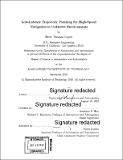| dc.contributor.advisor | Jonathan P. How. | en_US |
| dc.contributor.author | Lopez, Brett Thomas | en_US |
| dc.contributor.other | Massachusetts Institute of Technology. Department of Aeronautics and Astronautics. | en_US |
| dc.date.accessioned | 2017-02-22T19:01:17Z | |
| dc.date.available | 2017-02-22T19:01:17Z | |
| dc.date.copyright | 2016 | en_US |
| dc.date.issued | 2016 | en_US |
| dc.identifier.uri | http://hdl.handle.net/1721.1/107052 | |
| dc.description | Thesis: S.M., Massachusetts Institute of Technology, Department of Aeronautics and Astronautics, 2016. | en_US |
| dc.description | Cataloged from PDF version of thesis. | en_US |
| dc.description | Includes bibliographical references (pages 105-109). | en_US |
| dc.description.abstract | The ability for quadrotors to navigate autonomously through unknown, cluttered environments at high-speeds is still an open problem in the robotics community. Advancements in light-weight, small form factor computing has allowed the application of state-of-the-art perception and planning algorithms to the high-speed navigation problem. However, many of the existing algorithms are computationally intensive and rely on building a dense map of the environment. Computational complexity and map building are the main sources of latency in autonomous systems and ultimately limit the top speed of the vehicle. This thesis presents an integrated perception, planning, and control system that addresses the aforementioned limitations by using instantaneous perception data instead of building a map. From the instantaneous data, a clustering algorithm identifies and ranks regions of space the vehicle can potentially traverse. A minimum-time, state and input constrained trajectory is generated for each cluster until a collision-free trajectory is found (if one exists). Relaxing position constraints reduces the planning problem to finding the switching times for the minimum-time optimal solution, something that can be done in microseconds. Our approach generates collision-free trajectories within a millisecond of receiving perception data. This is two orders of magnitude faster than current state-of-the art systems. We demonstrate our approach in environments with varying degrees of clutter and at different speeds. | en_US |
| dc.description.statementofresponsibility | by Brett Thomas Lopez. | en_US |
| dc.format.extent | 109 pages | en_US |
| dc.language.iso | eng | en_US |
| dc.publisher | Massachusetts Institute of Technology | en_US |
| dc.rights | MIT theses are protected by copyright. They may be viewed, downloaded, or printed from this source but further reproduction or distribution in any format is prohibited without written permission. | en_US |
| dc.rights.uri | http://dspace.mit.edu/handle/1721.1/7582 | en_US |
| dc.subject | Aeronautics and Astronautics. | en_US |
| dc.title | Low-latency trajectory planning for high-speed navigation in unknown environments | en_US |
| dc.type | Thesis | en_US |
| dc.description.degree | S.M. | en_US |
| dc.contributor.department | Massachusetts Institute of Technology. Department of Aeronautics and Astronautics | |
| dc.identifier.oclc | 971022230 | en_US |
